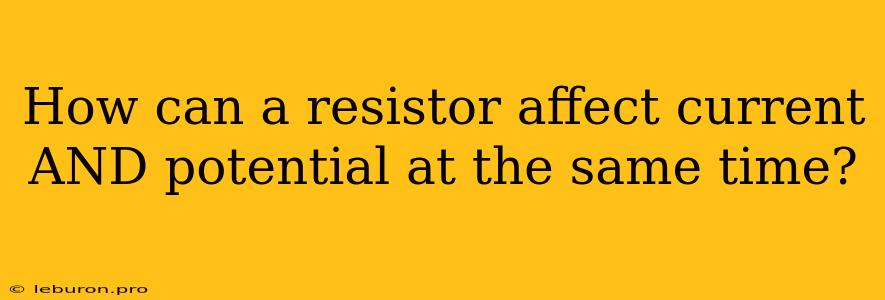Resistors are fundamental components in electronic circuits, playing a crucial role in controlling the flow of electric current. While they are primarily known for their ability to resist the flow of current, resistors also have a significant impact on the electrical potential across their terminals. This article will delve into the fascinating relationship between resistors, current, and potential, explaining how a resistor can affect both simultaneously.
The Fundamental Role of Resistance
Resistance, measured in ohms (Ω), is a property of a material that opposes the flow of electric current. Think of it as a bottleneck in a pipe carrying water. The narrower the bottleneck (higher resistance), the more difficult it is for the water (current) to flow through.
Ohm's Law: The Connection Between Resistance, Current, and Potential
The relationship between resistance, current, and potential difference is elegantly captured by Ohm's Law:
V = I * R
Where:
- V is the potential difference (voltage) across the resistor, measured in volts (V).
- I is the current flowing through the resistor, measured in amperes (A).
- R is the resistance of the resistor, measured in ohms (Ω).
This equation tells us that the potential difference across a resistor is directly proportional to the current flowing through it and the resistance of the resistor.
How Resistors Affect Current
As mentioned earlier, the primary function of a resistor is to limit the flow of current. The higher the resistance, the lower the current for a given voltage. This is why resistors are used in circuits to:
- Protect delicate components: Resistors can limit the current flowing through sensitive components, preventing them from being damaged by excessive current.
- Control the brightness of LEDs: By varying the resistance, the amount of current flowing through an LED can be adjusted, thus controlling its brightness.
- Create voltage dividers: Resistors can be connected in series to create voltage dividers, allowing for the division of a larger voltage into smaller, more manageable voltages.
How Resistors Affect Potential
While resistors primarily affect the current, they also have a significant impact on the potential difference across them. This can be explained by understanding the concept of voltage drop.
Voltage Drop
When current flows through a resistor, it encounters resistance. This resistance leads to a loss of energy, resulting in a voltage drop across the resistor. The higher the resistance, the greater the voltage drop for a given current.
Think of it like this: Imagine a river flowing over a waterfall. The height of the waterfall represents the potential difference (voltage) of the river. As the river flows over the waterfall, it loses some of its energy, resulting in a drop in potential (voltage) at the bottom of the waterfall.
Examples of Voltage Drop in Action
- Series circuits: In a series circuit, the current flowing through each resistor is the same. However, the voltage drop across each resistor is different, depending on the resistance value. The higher the resistance, the larger the voltage drop.
- Voltage dividers: As mentioned earlier, resistors can be used to create voltage dividers. By connecting resistors in series, you can divide the input voltage into smaller outputs, with the voltage drop across each resistor being proportional to its resistance.
The Interplay of Current and Potential
The relationship between resistors, current, and potential is not independent. They are intertwined, influencing each other in a dynamic way. Let's illustrate this with a few examples:
- Increasing resistance: If you increase the resistance of a resistor in a circuit with a constant voltage, the current flowing through the resistor will decrease. However, the voltage drop across the resistor will increase. This is because the higher resistance creates a greater obstacle for the current, leading to a larger loss of energy.
- Decreasing voltage: If you decrease the voltage applied to a resistor, the current flowing through the resistor will also decrease. Since the resistance remains constant, the voltage drop across the resistor will also decrease.
Applications of Resistors in Electronics
Resistors are ubiquitous in electronics, playing vital roles in a wide variety of circuits and devices. Here are a few notable applications:
- LED lighting: Resistors are used in LED circuits to limit the current flowing through the LEDs, protecting them from damage and controlling their brightness.
- Audio amplifiers: Resistors are used in audio amplifiers to control the gain, filter out unwanted frequencies, and provide feedback.
- Microcontrollers: Resistors are used in microcontroller circuits to provide pull-up and pull-down functionality, control the input/output signals, and set the timing of various operations.
Conclusion
Resistors are powerful components that can control both the current flowing through them and the potential difference across them. Their impact on current and potential is tightly interconnected, as described by Ohm's Law. Understanding the interplay between resistance, current, and potential is essential for designing and troubleshooting electronic circuits effectively.
Remember that resistors are not simply passive elements that simply resist current. They actively shape the electrical behavior of a circuit, contributing to its functionality and performance. By understanding their role, we can harness their power to create innovative and reliable electronic devices.
